Lamb Island Pioneer Hall facts for kids
Quick facts for kids Lamb Island Pioneer Hall |
|
|---|---|

Lamb Island Pioneer Hall, 1994
|
|
| Location | Lucas Drive, Lamb Island, City of Redland, Queensland, Australia |
| Design period | 1919 - 1930s (interwar period) |
| Built | c. 1924 - 1930s |
| Official name: Lamb Island Pioneer Hall | |
| Type | state heritage (built) |
| Designated | 3 April 1995 |
| Reference no. | 601493 |
| Significant period | c. 1924, 1930s (fabric) 1920s-1956 (historical) 1978-ongoing (social) |
| Significant components | tank stand |
| Lua error in Module:Location_map at line 420: attempt to index field 'wikibase' (a nil value). | |
The Lamb Island Pioneer Hall is a special building on Lamb Island, Australia. It used to be a farmhouse, but now it's a community hall where people gather. It's located on Lucas Drive in the City of Redland, Queensland. This historic building was constructed around 1924 and was later expanded in the 1930s. Because of its importance, it was added to the Queensland Heritage Register on April 3, 1995.
Contents
A Look Back: The Hall's History
The building we know as Pioneer Hall was first built around 1924. It was a farmhouse for a person named Cecil Hine, who lived on Lamb Island.
Lamb Island's Early Days
Lamb Island was originally called Ngudurru. It's one of several islands in Moreton Bay, including Macleay, Russell, and Karragarra Islands. These islands are located southeast of Cleveland and east of Redland Bay. Land on these islands was first surveyed and sold in the late 1860s and early 1870s.
In 1871, John Harris bought all of Ngudurru (Lamb Island). John and his brother George had a shipping business in Brisbane. They also owned land on Macleay Island. Over time, the land on Lamb Island changed hands many times. Finally, Cecil Hine bought the land in 1919.
Farming Life on the Island
Cecil Hine arrived on Lamb Island in the mid-1910s. He married Amelia Cox in 1923. By the mid-1920s, Hine's farm was one of about five farms on the island. Lamb Island and its nearby islands were known for growing fruits like pineapples and bananas. People also gathered oysters from the waters around the islands.
Cecil Hine made his farmhouse bigger in the mid-1930s. He sold the property in 1956.
Becoming a Community Hub
In 1974, the property came under the care of the Redland Shire Council. Two years later, in 1976, a meeting was held in the "old farmhouse." People met there to restart the Lamb Island Progress Association. This group helps improve the community.
The farmhouse was in poor condition, but the community worked together to fix it up in 1977. After the repairs, it became known as Pioneer Hall. The official opening of Pioneer Hall happened in May 1978.
Today, Pioneer Hall is used for different community events. It's a place for voting on election days and for political meetings. Sometimes, community groups use it for their gatherings. The hall also has a small library where people can borrow or exchange books. It's a charming and historic building, and it's one of the few old farmhouses left on the island from the early 1900s.
What the Hall Looks Like
The Lamb Island Pioneer Hall is a simple, charming wooden cottage. It sits at the end of Lucas Drive on the eastern side of Lamb Island. The building is on the edge of a hill, looking down towards Moreton Bay and some grassy recreation areas.
Outside the Hall
The hall has a roof made of corrugated iron, shaped like a triangle (gabled). It's a simple rectangular building that stands on timber (wooden) stumps. There are covered porches, called verandahs, on the west and east sides. The eastern verandah used to be open but is now enclosed.
You enter the building from the western verandah, going up some central stairs. The eastern verandah offers nice views of Moreton Bay. The outside walls are mostly covered with weatherboard, which are long, overlapping wooden planks. There's also a section of chamferboard on the western verandah. You can see a corrugated iron water tank and a spot where a stove used to be on the north-west side. There are also wooden stairs at each end of the eastern verandah.
Inside the Hall
Inside, the Lamb Island Pioneer Hall has four rooms. On the eastern side, there's a kitchen and a library. On the western side, there's a larger meeting or recreation room. This big room used to be two separate rooms. The walls and ceilings inside are covered with wooden boards that fit together vertically. In some rooms, you can see the wooden frame of the building.
The hall also displays pictures and items that tell its story. For example, there's a painted wooden sign that says "FARM HOME of Mr & Mrs C.A. HINE BUILT in 1924." You can also see old photographs of the building and the people who used it, as well as paintings of the hall by local artists.
Why It's a Heritage Site
The Lamb Island Pioneer Hall was added to the Queensland Heritage Register on April 3, 1995. This means it's recognized as an important historical place. It met certain rules to be listed:
Showing Queensland's History
The hall is one of the few old farmhouses left on Lamb Island. It helps us understand how farming developed on the island, starting from the 1870s.
Important to the Community
The Lamb Island Pioneer Hall, which began as a farmhouse around 1924, is a central place for community activities on the island. It has a special connection with the people of Lamb Island.

